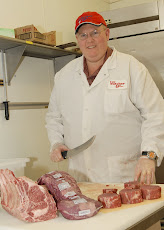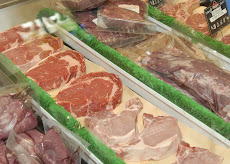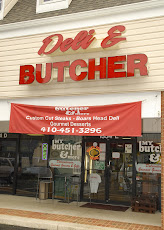Our Roseda Dry Aged Beef has such a natural nutty flavor that I feel it's almost sacreligious to add any additional seasoning. Kobe beef also has its own flavor characteristics that shouldn't be adulterated.
Now when talking about our regular wet aged beef, veal, lamb, or pork, salt and pepper works for me just to enhance the natural flavors in the meat.
Dredging meat in heavy seasonings like season all, blackening seasoning, or Cajun rubs has its benefits if you’re in the mood for lesser expensive meats and you need to add flavor or use these added seasonings to help tenderize the meat. But let's face it, if you’re purchasing a quality well aged middle meat from a reputable butcher like a rib eye, strip or tenderloin steak, you should not have to add any enhancers to it.
I have had the same question time and time again -- Doesn't salt pull the juices from the meat? I really don't think so. In general I lightly salt and pepper my steaks once they have come down to room temperature and sear them on high heat. Once seared they’re sealed! Now if you stab, fork, or press down on your steak, you better believe it's going to lose a lot of its natural juices. Try using tongs instead.
I'm a salt lover, but I also appreciate a good steak, so I know my limitations. Let’s face it - it's all about what you like. I'm not going to tell you how you like your steak.
I see new customers coming in all the time and ask how they should marinade our steaks. My advice is always that you should not have to marinade a well aged middle meat (strip, tenderloin or rib eye).
I bet you if you still continue to use these marinades or heavy seasoning with our steaks you will still see a BIG difference in better quality. But please try our steaks without all that added seasoning. Appreciate the natural quality.
If you learn to appreciate one of our fine steaks with little to no seasoning, you can be assured it will be healthier for you and better for your children in the long run, especially our all natural and organic meats.
If you have any questions, I will try to answer them. If I do not have the answer, I will try my best to find it for you. Just send me an email or stop by My Butcher and More and say hi!
Happy Grilling!
Mike Smollon
meatheadchef@aol.com for questions
http://www.mybutcherandmore.com/
Sunday, September 28, 2008
Monday, September 22, 2008
Middle Meats vs. Outside Meats
When I use the the terminology middle meats vs. outside meats, my reference is to the location of the cuts in the animal.
Example: Middle Meats: Rib and Loin
Rib : Rib eyes, Rib Roast etc.
Loin: Strip Loin, Tenderloin, Sirloin
These middle meats are your non-working muscles so there more tender usually best grilled, pan seared or broiled marinating should not be needed if you're purchasing your meats from a reputable butcher. These steaks may just be lightly seasoned and quickly cooked to your preferred internal temperature.
My favorite middle meat is the Porterhouse. You have the strip on one side and the tenderloin on the other. If you're buying for two, ask for a thick porterhouse steak so you can grill just one and split between the two of you. Grilling meat on the bone is always the best - the bone adds a lot more flavor to your steak.
____________________________________________________________________________________________________
Example: Outside Meats: Leg, Shoulder
(H) Leg:Top Round, Eye Round, Rump, Hind Shank
(F) Leg: Chuck, Brisket, Fore Shank
Belly: Flank, Skirt
These meats are considered working muscles so they're proned to be cooked either with moisture (braised) or roasted slowly. If you are grilling an eye round, top round or chuck eye steak, marinating the steak beforehand is a must. The muscle fiber in these cuts are tight and need to be broken down. Some cuts need more marination than others. If you're purchasing your product from My Butcher and More or another reputable market, ask the butcher the recommended time for your cut to marinate.
My favorite outside meats are the briskets. They have enough internal fat to keep the meat fork tender if you slow roast or smoke it for several hours. The other is the skirt steak. With just a little marinating in our bourban glaze or just using salt and pepper, this meat is awesome!
Please try to support small businesses when you can where quality and service is always' the best!
Example: Middle Meats: Rib and Loin
Rib : Rib eyes, Rib Roast etc.
Loin: Strip Loin, Tenderloin, Sirloin
These middle meats are your non-working muscles so there more tender usually best grilled, pan seared or broiled marinating should not be needed if you're purchasing your meats from a reputable butcher. These steaks may just be lightly seasoned and quickly cooked to your preferred internal temperature.
My favorite middle meat is the Porterhouse. You have the strip on one side and the tenderloin on the other. If you're buying for two, ask for a thick porterhouse steak so you can grill just one and split between the two of you. Grilling meat on the bone is always the best - the bone adds a lot more flavor to your steak.
____________________________________________________________________________________________________
Example: Outside Meats: Leg, Shoulder
(H) Leg:Top Round, Eye Round, Rump, Hind Shank
(F) Leg: Chuck, Brisket, Fore Shank
Belly: Flank, Skirt
These meats are considered working muscles so they're proned to be cooked either with moisture (braised) or roasted slowly. If you are grilling an eye round, top round or chuck eye steak, marinating the steak beforehand is a must. The muscle fiber in these cuts are tight and need to be broken down. Some cuts need more marination than others. If you're purchasing your product from My Butcher and More or another reputable market, ask the butcher the recommended time for your cut to marinate.
My favorite outside meats are the briskets. They have enough internal fat to keep the meat fork tender if you slow roast or smoke it for several hours. The other is the skirt steak. With just a little marinating in our bourban glaze or just using salt and pepper, this meat is awesome!
Please try to support small businesses when you can where quality and service is always' the best!
Thursday, September 11, 2008
Choosing Cuts
This is my first blog attempt, so I hope this will be one of many useful postings for you as I share my vast knowledge of the the meat business.
I have spent over 35 years in the the foodservice business starting as a dishwasher at the Harbor House in Annapolis in high school back in 1976. Then I worked my way up the ladder to attending The Culinary Institue of America in Hyde Park, New York (CIA), graduating in1980.
Soon after the CIA, I realized nights, weekends and holidays for a young man wasn't going to cut it for me (pardon the pun) so I landed a sales position in a restaurant distribution business selling to high-end steakhouses, country clubs, and hotels in Washington and N. Virginia. Not wanting to be left speechless during a sales call, I strove to learn all I could about what I was selling, especially since I was meeting with Executive Chefs and owners of restaurants like Blackies House of Beef and Sam and Harry's in DC. I stayed late after work and spent many hours in the meat cutting rooms asking questions and eventually had some hands on practice.
I still ask questions, never stop. Now I'm the owner and have a responsibilty to my valued customers to give out the right information. Being honest about what we have to offer is priority one to me at My Butcher and More. I'm a "go to" person for fresh meat information. Do I know everything? NO. Can I offer good advice about grilling? YES.
This first blog entry is about choosing the best cuts - what to look for in both the best quality and the worst.
Beef for Consumption (steer) vs. Dairy cattle (cow).
1. Steers are raised from birth to slaughter for consumption only.
A . The fat is very white in color, the muscle (red portion) is pink to light red, and the steak or chop is stocky in width hand length.
B. A natural beef flavor exists and the texture should be free of grainy, stringy or chewy bites.
C. A steer is a naturally stocky animal that is fattened for consumption.
2. Diary Cattle (cow)
A. The fat is less white to yellow in color, the muscle is most times darker red to almost light purple, and the steak or chop is long and narrow. If you have every seen a dairy cow, you'll notice it's narrow in width and its belly hangs low. That's from the years of milking. These cows are milked out then fed grain to fatten for consumption. The USDA can grade this inferior product as USDA Prime or Choice if it meets the criteria of the marbling (fleck of fat) score in the muscle (red meat) that is required to authenticate the proper grade standards.
B. The flavor is grassy with texture being grainy, stringy and sometimes chewy. "You can put a fur coat on a cow but it's still a cow!"
3. Labeling
A. Look carefully at what you're buying. Many of my customers tell me most of the pork and chicken sold in your average grocery stores are marinated or pumped with a sodium solution. This is done to give the product a longer shelf life, add flavor and or make it tender. So in turn you're getting a lesser quality product that's been adulterated to make better profits. I recommend you shop at a health-conscious store like My Butcher and More or another locally owned small business who cares about their valued customer's health.
B. What is a USDA Grade? It's a requirement by the US Department of Agriculture to hold the farmers accountable for marketing their product for its true value for quality.
Top Grade to the Lowest sold in grocery stores and butcher shops:
USDA Prime - USDA Choice - USDA Select.
Other grades lower than USDA Select go into TV dinners, canned products, and pet food.
Next week's blog will be about tips for grilling middle meats (higher end cuts) and outside meats (economy cuts).
Email me with any of your questions at meatheadchef@aol.com.
Until next week - happy eating!
I have spent over 35 years in the the foodservice business starting as a dishwasher at the Harbor House in Annapolis in high school back in 1976. Then I worked my way up the ladder to attending The Culinary Institue of America in Hyde Park, New York (CIA), graduating in1980.
Soon after the CIA, I realized nights, weekends and holidays for a young man wasn't going to cut it for me (pardon the pun) so I landed a sales position in a restaurant distribution business selling to high-end steakhouses, country clubs, and hotels in Washington and N. Virginia. Not wanting to be left speechless during a sales call, I strove to learn all I could about what I was selling, especially since I was meeting with Executive Chefs and owners of restaurants like Blackies House of Beef and Sam and Harry's in DC. I stayed late after work and spent many hours in the meat cutting rooms asking questions and eventually had some hands on practice.
I still ask questions, never stop. Now I'm the owner and have a responsibilty to my valued customers to give out the right information. Being honest about what we have to offer is priority one to me at My Butcher and More. I'm a "go to" person for fresh meat information. Do I know everything? NO. Can I offer good advice about grilling? YES.
This first blog entry is about choosing the best cuts - what to look for in both the best quality and the worst.
Beef for Consumption (steer) vs. Dairy cattle (cow).
1. Steers are raised from birth to slaughter for consumption only.
A . The fat is very white in color, the muscle (red portion) is pink to light red, and the steak or chop is stocky in width hand length.
B. A natural beef flavor exists and the texture should be free of grainy, stringy or chewy bites.
C. A steer is a naturally stocky animal that is fattened for consumption.
2. Diary Cattle (cow)
A. The fat is less white to yellow in color, the muscle is most times darker red to almost light purple, and the steak or chop is long and narrow. If you have every seen a dairy cow, you'll notice it's narrow in width and its belly hangs low. That's from the years of milking. These cows are milked out then fed grain to fatten for consumption. The USDA can grade this inferior product as USDA Prime or Choice if it meets the criteria of the marbling (fleck of fat) score in the muscle (red meat) that is required to authenticate the proper grade standards.
B. The flavor is grassy with texture being grainy, stringy and sometimes chewy. "You can put a fur coat on a cow but it's still a cow!"
3. Labeling
A. Look carefully at what you're buying. Many of my customers tell me most of the pork and chicken sold in your average grocery stores are marinated or pumped with a sodium solution. This is done to give the product a longer shelf life, add flavor and or make it tender. So in turn you're getting a lesser quality product that's been adulterated to make better profits. I recommend you shop at a health-conscious store like My Butcher and More or another locally owned small business who cares about their valued customer's health.
B. What is a USDA Grade? It's a requirement by the US Department of Agriculture to hold the farmers accountable for marketing their product for its true value for quality.
Top Grade to the Lowest sold in grocery stores and butcher shops:
USDA Prime - USDA Choice - USDA Select.
Other grades lower than USDA Select go into TV dinners, canned products, and pet food.
Next week's blog will be about tips for grilling middle meats (higher end cuts) and outside meats (economy cuts).
Email me with any of your questions at meatheadchef@aol.com.
Until next week - happy eating!
Subscribe to:
Posts (Atom)


